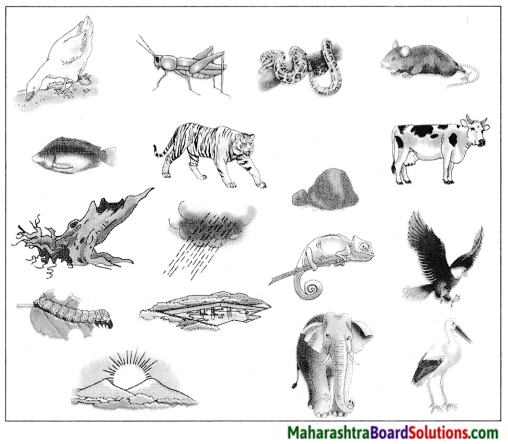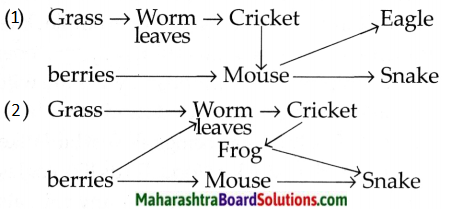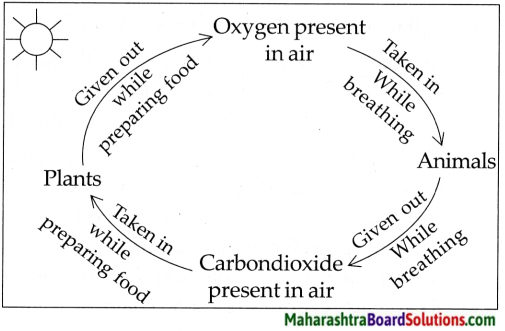Balbharti Maharashtra State Board Class 5 Environmental Studies Solutions Chapter 4 Environmental Balance Notes, Textbook Exercise Important Questions and Answers.
Maharashtra State Board Class 5 EVS Solutions Part 1 Chapter 4 Environmental Balance
5th Std EVS 1 Digest Chapter 4 Environmental Balance Textbook Questions and Answers
1. What’s the solution?
Question 1.
We have to remove insects from the grains without using pesticides.
Answer:
Some plants like neem or their extract repel insects. That is insects run away from these substances. Hence if we place dried leaves of neem. The grains will be freed from the insects as they will go away. Similarly it is by applying canola oil to the grains we can remove the insects as canola oil is also an insect repellent.
![]()
2. Use your brain power.
Question 1.
Use your brain power.
Make up a food chain:
Frog, Kite, Worm, Snake, Grass
Answer:
Grass → Worm → Frog → Snake → Kite
3. Answer the following questions:
Question (a)
What is a food chain? Give an example of it.
Answer:
In nature, Plants are food for one small animal. This smaller animal is the food for a larger animal which in turn is a food for another larger animal. Thus we see that one living thing is connected to another living thing for their food, and each component or living thing is the food for the next one. Therefore we can say the components form a chain. Such a biological chain is called a food chain. Example of a food chain.
Plants → Grasshopper → Frog → Snake → Kite
The plant is eaten by the grasshopper which is eaten by the frog. The frog is eaten by the snake which is eaten by the kite.
Question (b)
How is the balance in the environment maintained?
Answer:
1. Plants use substances in the soil for their growth and when plants and animals die the micro-organisms decompose them and this added to the substances goes back to the soil once again.
2. Similarly the water cycle maintains a continuous supply of water for all the living things.
3. Living things take in oxygen and give out carbon dioxide while breathing. The plants take in carbon dioxide and give out oxygen while preparing their food. Thus oxygen gets added to the air.
There are several other such cycles which go on in nature due to interaction amongst living things. When such interactions and cycles go on uninterrupted continuously, they help in maintaining the food chain. Due to this, environmental balance is maintained.
4. What substances in the soil are useful for the growth of plants?
Question 1.
What substances in the soil are useful for the growth of plants?
Answer:
The plants use substances like water, minerals and organic matter from the soil for their growth.
Note: Grasshopper does not feed on worms. It is not a flesh eating insect. It eats only various parts of plants like seeds & leaves. The first image shown in the textbook on page 20 is of an insect called cricket, which feeds on worms, and the bird feeds on this cricket.
Hence the correct food chain is
grass → worm → cricket (insect) → bird
![]()
5. True or false?
Question 1.
True or false?
- Microorganisms form a part of the environment.
- It is necessary to maintain biodiversity.
- A grasshopper eats birds.
Answer:
- True
- True
- False
Environmental Studies Part 1 Standard 5th Solutions Chapter 4 Environmental Balance Additional Important Questions and Answers
Fill in the blanks with the correct answers from the options given below:
Question 1.
The variety we see in all living things that belong to a particular area is called ………………. of that place.
(a) biodiversity
(b) environment
(c) food chain
Answer:
(a) biodiversity
Question 2.
While studying biodiversity of a given place scientists make large number of ………………….. in different conditions using special devices.
(a) observation
(b) specification
(c) direction
Answer:
(a) observation
Question 3.
The science which studies interaction between living and non living things is known as ……………….. .
(a) environmental science
(b) food web
(c) water cycle
Answer:
(a) environmental science
![]()
Question 4.
The soil, air, water, plants, animals and microorganisms are known as the ……………… of the environment.
(a) dividents
(b) components
(c) substance
Answer:
(b) components
Question 5.
A ………………. is formed by interlinking of several food chains.
(a) food store
(b) junk food
(c) food web
Answer:
(c) food web
Question 6.
………………… make their own food using water and carbon dioxide in the presence of sunlight.
(a) Plants
(b) Animals
(c) Humans
Answer:
(a) Plants
Question 7.
………………… decompose the dead remains of plants and animals present in the soil.
(a) plants
(b) micro-organism
(c) animals
Answer:
(b) micro-organism
Question 8.
All the living organisms get a continuous supply of water in nature because of the water ……………… .
(a) fountain
(b) clouds
(c) cycle
Answer:
(c) cycle
Question 9.
Plants give out ………………. gas while preparing their food.
(a) carbon dioxide
(b) oxygen
(c) sulphur dioxide
Answer:
(b) oxygen
Question 10.
Plants take in ………………….. gas from the air while preparing food.
(a) carbon dioxide
(b) oxygen
(c) mitrogen
Answer:
(a) carbon dioxide
Question 11.
When cycles go on uninterrupted in nature, ……………….. balance is maintained in nature.
(a) environmental
(b) botanical
(c) geographical
Answer:
(a) environmental
![]()
Question 12.
Living and non-living things are ………………….. on each other.
(a) independent
(b) interdependent
(c) dependent
Answer:
(c) dependent
Question 13.
One living thing can be a part of a number of food …………………. .
(a) web
(b) chains
(c) link
Answer:
(b) chains
Question 14.
Every living thing gets its food from the …………………… .
(a) environment
(b) nature
(c) kitchen
Answer:
(a) environment
Question 15.
Many animals in the environment eat only
(a) animals
(b) plants
(c) grass
Answer:
(b) plants
Question 16.
Animals eat other animals that live on …………………. .
(a) plants
(b) animals
(c) humans
Answer:
(a) plants
Question 17.
……………………… are the main support of every food chain.
(a) Animals
(b) Plants
(c) Humans
Answer:
(b) Plants
Question 18.
Due to the ………………… every living thing gets the food it needs and therefore continues to live.
(a) food chain
(b) water cycle
(c) oxygen
Answer:
(a) food chain
Question 19.
………………. living in the soil helps the process of decomposition.
(a) Worms
(b) Microorganisms
(c) Insects
Answer:
(b) Microorganisms
Question 20.
Living things use …………………. from the air for breathing.
(a) oxygen
(b) nitrogen
(c) carbon
Answer:
(a) oxygen
![]()
Question 21.
Plants use ………………. from the air for making their food.
(a) oxygen
(b) carbon dioxide
(c) nitrogen
Answer:
(b) carbon dioxide
Question 2.
Find the odd man out and state its reasons:
- Snake, Cow, Grains, Mouses
- Sparrow, Grass, Elephant, Worm
- Water, Soil, Microorganisms, Sun
Answer:
- Cow – (Snake, Mouse, Grains form a food chain.)
- Elephant – (Sparrow, worm, grass form a food chain.)
- Microorganism (water, soil, air are non-living components of the environment.)
Question 3.
State whether the following statements are true or false:
- Plants give out oxygen while breathing.
- If forests are destroyed environmental balance is disturbed.
- Tigers, Lions and Leopards harm the environment.
- When substances present in nature are used up by the living organisms they are returned back to the soil after decomposition of their dead bodies.
- In a given environment we always see only one type of food chain.
- A mouse can be a link of two different food chains.
- Pollution of air, water and soil can disturb the environmental balance.
Answer:
- False
- True
- False
- True
- False
- True
- True
Question 4.
Give one word for the following processes:
1. Process of give and take between living things and non living things.
2. Process of breaking down of dead bodies into simpler substances so that the plants can use it.
Answer:
1. Interaction
2. Decomposition
Question 5.
Use your brain power. Make up a food chain:
- Deer, Plants, Tiger, Microorganisms
- Sea lion, Algae, Small fish, Big fish
- Owl, Nuts, Squirrel, Fox
- Algae, Dragon fly, Mosquito larvae, Chameleon
- Grass, Fox, Bird, Snail
- Grasshopper, Cow, Turkey bird, Grass, Humans
- Elephant Calf, Lion, Plants, Deer
- Snakes, Caterpillars, Chicken, Eagles
- Flowers of plant, Falcon (Bird), Lizard, Honeybee
Answer:
1. Plants → Deer → Tiger → Microorganisms
2. Algae → Small fish → Large fish → Sea lion → Shark
3. Nuts → Squirrel → Owl → Fox
4. Algae → Mosquito larvae → Dragonfly → Chameleon
5. Grass → Snail → Bird → Fox

9. Caterpillars → Chicken → Snake → Eagle
10. Flowers of plants → Honeybee → Spider → Lizard → Falcon (Bird)
![]()
Answer the following in one or two sentences:
Question 1.
Which living organism is the main support of every food chain?
Answer:
The plants which prepare their own food are the main support of every food chain.
Question 2.
What is the food of the plants?
Answer:
Plants prepare their own food using carbon dioxide from air and water from the soil in presence of sunlight.
Question 3.
What is an environment?
Answer:
The surroundings and the conditions in those surroundings which affect the life of the organisms there, are together known as their environment.
Question 4.
What are the components of the environment?
Answer:
Sunlight, air, water, soil, plants and animals etc. are the components of the environment.
Question 5.
What is a food web?
Answer:
One living thing can be a part of a number of food chains. That gives rise to a food web in nature.
Question 6.
Name the following (Give any two examples):
- Animals which eat only plants.
- Animals which eat animals that live on plants.
- Birds which eat insects.
- Birds which eat fruits or seeds of plants.
- Birds which eat small animals or small birds.
- Birds and animals which eat dead animals.
Answer:
- Goat, Cow, Elephant, Rhinoceros
- Tiger, Lion, Leopard, Cheetah
- Robin, Peacock, Chicken (Hen), Woodpecker
- Sparrow, Pigeon, Parrot, Toucans, Canary
- Kite, Eagle, Falcon, Hawk, Owl
- Vulture, Hyena, Crow, Raccoons
Give reasons:
Question 1.
Plants are the main support of every food chain.
Answer:
Many animals in the environment eat only plants. Some animals eat smaller animals that live on plants. Plants make their own food using water from soil and carbon dioxide from air in the presence of sunlight. They are the only living organisms which do not depend for their food on other animals. All other animals directly or indirectly depend on plants for food. Hence, plants are the main support of every food chain.
![]()
Question 2.
It is important to maintain the environmental balance for existence of living things.
Answer:
When various cycles present in nature go on uninterrupted, environmental balance is maintained in nature. This helps in maintaining the food chains in the environment. If environmental balance is not maintained the food chains get affected and some animals may die due to shortage of food. If this continues, it will destroy nature and all the living things. Therefore, to maintain the food chains and existence of living things environmental balance should be maintained.

State how the following non-living things found in nature are useful to living things:
Question 1.
Hollow of a tree:
Answer:
Many animals like squirrels, birds etc. take shelter in the hollow of the tree. Insects also are known to be found in this hollow.
Question 2.
Rocks:
Answer:
Small rocks present in the soil help the roots of the plant to breathe and grow as they allow air and water to pass through the soil. Soil which helps plant to grow is formed by breaking down of these rocks. Many insects also take shelter under large rocks e.g. Scorpions live below the rocks.
Question 3.
Sun:
Answer:
The Sun is the source of energy. It provides sunlight. Plants cannot grow without sunlight. Hence no life would exist without the Sun.
Question 4.
Mountains:
Answer:
Large forests are found on mountains. Rivers also originate in mountains. Hence, mountains are homes for many living things. They are homes for many birds, monkeys, wild animals etc.
Answer the following questions:
Question 1.
What do you mean by a link in a food chain? If one of the links in a chain is lost from the chain, can the food chain last? Explain.
Answer:
In a food chain, one animal is the food for the next animal. Each one of the living things forming a food chain is called the link of the food chain. If one link of the food chain is lost it will affect the next link. It means if one animal is lost, the next animal for which it is the food will also get affected, as it will cause shortage of food.
This will lead to starvation8 and death of the animals in the next link. For Example: If deer disappear from the forest, the lions and tigers will starve for food and they will die. Thus we see that the food chain will not last if one link in the food chain is lost.
![]()
Question 2.
Who eats birds?
Answer:
Birds are eaten by various animals depending on their size. Small birds like sparrow, robins, canary etc. are eaten by snakes. Pythons can eat large birds like herons, stork, etc. by coiling around them and crushing them. Dogs, cats also eat birds like chicken, hens etc. Some large birds eat the young ones of birds or smaller birds.
For example: kite, eagle, owls, falcons eat small birds or young ones of other birds. Foxes, racoons, coyotes are wild animals which eat small birds and other birds like owls. Lastly human beings also eat birds like, chicken, turkey, duck as food. Birds like eagles, kite and vultures are not eaten by any animals. Microorganisms decompose them after they die.
Question 3.
Explain how the balance in the level of oxygen and carbon dioxide present in the air is maintained in nature.
Answer:
The animals take in oxygen and give out carbon dioxide while breathing. However plants take in carbon dioxide and give out oxygen while preparing food. Due to this process the balance in the level of oxygen and carbon dioxide present in the air is maintained.
Question 4.
Describe the water cycle present in nature.
Answer:
Our earth is covered with water bodies. The heat of the sun evaporates the water from the water bodies like sea, lake, ponds stveanes of rivers and also the water which has percolated beneath the soil. This evaporated water vapour is light, so it moves up into the higher and cooler atmosphere to form fine drops of water which float.
These smaller drops form clouds. They later join together to form big and heavy drops; which fall down as rain. The rain water goes back to the water bodies, thus the process of condensation, evaporation and rainfall continue to form a water cycle.
Observe the picture given below and answer the following:

Question (A)
Find the different food chains of whichthe worm and the mouse form a link:
Answer:
There are two food chains as shown below :

![]()
Question (B)
Find the different food chains where the fox and lion form a link.
Answer:
There are two food chains as shown below:

Question 1.
Draw a diagram showing the water cycle occurring in Nature:
Answer:

Question 2.
Draw a diagram showing the oxygen cycle:
Answer:

What’s the solution?
Question 1.
Mosquitoes cause malaria. To prevent malaria mosquitoes need to be stopped from growing.
Answer:
Mosquitoes larvae grow in water. Hence to prevent them from growing we should not allow water to accumulate. We should keep our surroundings dry. Also fishes like guppies, gold fish and killifish eat up the mosquto larvae. Hence sometimes these fish are grown in ponds to prevent mosquitoes.
![]()
Question 2.
The soil is to be made fertile without adding chemical fertilizers.
Answer:
Organic manure is added to the soil. Organic manure is prepared by mixing remains of plants, vegetables, fruits etc. with soil and is allowed to decompose by microorganisms. Microorganisms convert the above substances to organic manure which helps plants to grow.
Can you tell?
Question 1.
What is the deer’s food?
Answer:
The deer feeds on various kinds of plants and grass. They eat leaves, twigs and stems of the plant.
Question 2.
What is food for the tiger?
Answer:
The tiger feeds on plant eating animals like deer, cows, zebra, giraffe, goats, buffaloes, rhinoceros, calf etc.
![]()
Glossary:
- interaction – a particular way in which matter affects one another
- component – part of a larger whole
- residues – a small amount that remains behind.
- uninterrupted – without break.
- organic – derived from living matter
- presence – being present.
- hollow – having a hole or empty space inside.